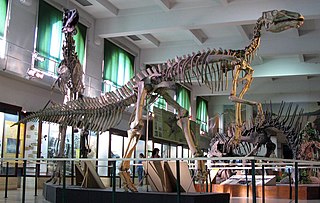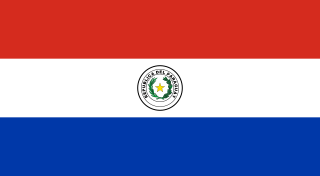
Alvarezsaurus is a genus of small alvarezsaurid dinosaur from the Late Cretaceous period, living in Argentina, approximately 86 - 83 million years ago. Estimates suggest that it measured about 2 meters (6.5 ft) in length and weighed approximately 20 kg (45 lbs). Gregory S. Paul estimated in 2010 its weight at 3 kg and length at 1 m. It was found in the Bajo de la Carpa Formation and was named by paleontologist José Bonaparte in 1991 after the historian Don Gregorio Alvarez. The type species is A. calvoi.

Velocisaurus is a genus of ceratosaurian theropod dinosaur from the Late Cretaceous period of Argentina.
Bonatitan is a genus of titanosaurian dinosaur from the Late Cretaceous Allen Formation of Argentina.
Unquillosaurus is a genus of maniraptoran dinosaur from the Late Cretaceous Period, discovered in Argentina. Known only from a single fossilized pubis, its total body length may have reached 2 to 3 metres.

Secernosaurus is a genus of herbivorous dinosaur. Secernosaurus was a hadrosaur, a "duck-billed" dinosaur which lived during the Late Cretaceous. Its fossils have been found in the Lago Colhué Huapi and Los Alamitos Formations of Argentina.

Compsosuchus is an extinct genus of abelisaurian dinosaur. It lived during the Late Cretaceous in India.

Cramauchenia is an extinct genus of litoptern South American ungulate. Cramauchenia was named by Florentino Ameghino. The name has no literal translation. Instead, it is an anagram of the name of a related genus Macrauchenia. This genus was initially discovered in the Sarmiento Formation in the Chubut Province, in Argentina, and later it was found in the Chichinales Formation in the Río Negro Province and the Cerro Bandera Formation in Neuquén, also in Argentina, in sediments assigned to the SALMA Colhuehuapian. In 1981 Soria made C. insolita a junior synonym of C. normalis. A specimen of C. normalis was described in 2010 from Cabeza Blanca in the Sarmiento Formation, in sediments assigned to the Deseadan SALMA(Upper Oligocene).
Octávio Mateus is a Portuguese dinosaur paleontologist and biologist Professor of Paleontology at the Faculdade de Ciências e Tecnologia da Universidade Nova de Lisboa. He graduated in Universidade de Évora and received his PhD at Universidade Nova de Lisboa in 2005. He collaborates with Museu da Lourinhã, known for their dinosaur collection.

The Museo Nacional de Ciencias Naturales is the National Museum of Natural History of Spain. It is situated in the center of Madrid, by the Paseo de la Castellana. It is managed by the Spanish National Research Council.

The Disteniidae are a small family of beetles in the superfamily Chrysomeloidea, traditionally treated as a group within the Cerambycidae.

Hugo Gunckel Lüer was a Chilean pharmacist, botanist, and university professor.
Devincenzia is an extinct genus of giant flightless predatory birds in the family Phorusrhacidae or "terror birds" that lived during the Early Miocene (Deseadan) Fray Bentos Formation of Uruguay and Late Miocene (Huayquerian) Ituzaingó Formation to Early Pliocene (Montehermosan) of Argentina. The type species D. pozzi was formerly known as Onactornis pozzi. A second species D. gallinali has been described. It stood about 2.5 metres (8.2 ft) tall.

The harmless serotine is a species of vesper bat. It is found in western Ecuador and northwestern Peru.
Revista del Museo Argentino de Ciencias Naturales is a peer-reviewed natural sciences journal published by the Museo Argentino de Ciencias Naturales. This journal is a merger of all subseries of: Revista del Museo Argentino de Ciencias Naturales "Bernardino Rivadavia" e Instituto Nacional de Investigación de las Ciencias Naturales, and all subseries of: Comunicaciones del Museo Argentino de Ciencias Naturales "Bernardino Rivadavia" e Instituto Nacional de Investigación de las Ciencias Naturales.

Peter Jørgensen was a Danish early 20th century entomologist, active particularly in Argentina and Paraguay.

Bicentenaria is a genus of carnivorous coelurosaurian theropods which lived during the early Late Cretaceous in what is now Argentina. It contains the type species, Bicentenaria argentina. Estimates suggest that it was 2.5 to 3 metres in length. This name was first reported in news articles in June 2012, and the paper describing it was formally published in August 2012.
Obereoides is a genus of longhorn beetles of the subfamily Lamiinae, containing the following species:
The University of Argentine Social Museum is a university in Argentina. Founded on November 5, 1956 in the city of Buenos Aires, it consists of 5 departments:

Juan (Jean) Brèthes, also known as Frère Judulien Marie or Juan Brethes was an Argentine scientist, naturalist, entomologist, ornithologist, zoologist and geologist. He was the first entomologist of the National Museum, today known as the Argentine Museum of Natural Sciences. He was a close collaborator of Florentino Ameghino, and translated several of his works into French. Thanks to his intense activity, he systematized a large number of Latin American insect species. He was a precursor in the fight against agricultural pests at a time when insecticides had not been developed to combat them.
Diplostomidae is a family of trematodes in the order Diplostomida.














